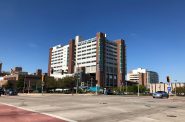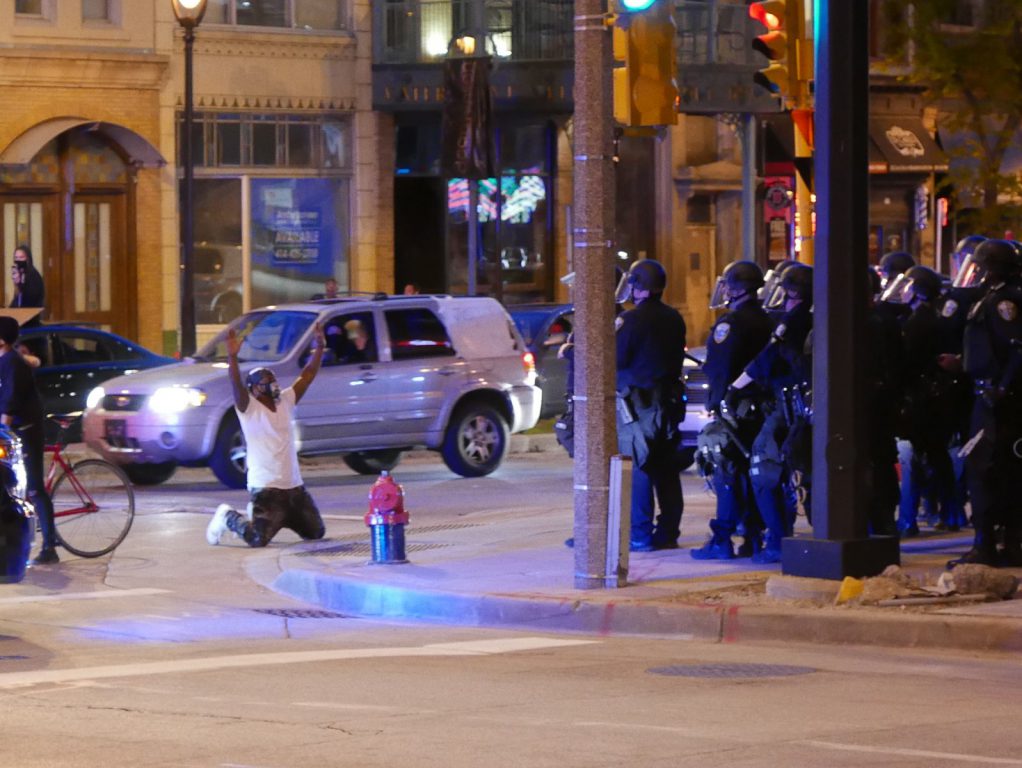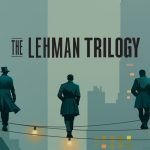8 Ways Police Mishandled Protests
From Los Angeles to New York, Milwaukee and Wauwatosa, police made similar mistakes.
A independent report issued this month offered a scathing assessment of the Los Angeles Police Department’s handling of protests last summer responding to George Floyd’s death, charging the police illegally detained protesters and attacked people who had committed no crimes with rubber bullets, bean bags and batons.
It was one of more than a dozen such reports, all but one castigating a police department for how it handled the Black Lives Matter protests. As the Indianapolis review noted, the response of officers there “were not dissimilar to what appears to have occurred in cities around the country.”
There were no such reports in Wisconsin, but the way police handled protests in Milwaukee, Wauwatosa and Kenosha often fit into the same pattern, one described in these reports and media accounts of protests. Among the common problems are these:
1. Poor organization and communication. “High-ranking officers sometimes made chaotic scenes even worse by shifting strategies without communicating clearly,” as the analysis of the Los Angeles Police concluded. The Philadelphia police were unprepared and lacked a plan to handle the protests an analysis found. In Wisconsin both the Wauwatosa and Kenosha police departments seemed unprepared for what they encountered.
2. Use of untrained police to handle protests and a general lack of training for department in how to respond to protests.
3. Indiscriminate use of force. Across the country there were complaints of this. The Portland Police Bureau used force more than 6,000 times in six months, a review there found.
4. Police were heavily militarized, wearing riot gear — with helmets, face shields, reinforced vests and sometimes carrying batons — looking more like an army than peace officers. “Kenosha, Madison, Milwaukee and Wauwatosa… saw police don body armor and fire crowd control weapons during protests,” as one story noted.
5. Use of tear gas, pepper balls, rubber bullets and other so-called “less-lethal” weapons. In one notable incident, Milwaukee Police cornered a crowd of protestors and then attacked them with tear gas. Mayor Tom Barrett called on Milwaukee Police to stop using tear gas and rubber bullets. Elsewhere, some protesters were injured so severely by these weapons that they had to get surgery. Nationally, at least eight people were blinded after being hit with police projectiles. In Raleigh, N.C., a report found that videos appeared to show officers using pepper spray indiscriminately.
6. Racial discrimination in policing. In Philadelphia, officers fueled unrest in some predominantly Black areas with excessive force against demonstrators, while allowing white men armed with bats and pipes to confront protesters in other parts of town. In Kenosha police cracked down on Black protestors while welcoming and offering water to white vigilantes carrying weapons, including Kyle Rittenhouse, who shot and killed two people.
7. Police lacked transparency or hid what they were doing, Officers in some cities “obscured their badge numbers and name plates, and many did not wear body cameras, making it difficult to hold officers accountable for misconduct,” the Times reports. The Tosa police are moving towards using body cameras, but were not equipped with them during the protests. The Milwaukee police claimed a molotov cocktail had been thrown at a protest, to justify their use of tear gas and rubber bullets, but it turned out to be a water bottle. Tosa police claimed the arrest of 40 protestors for which there is no documentation.
8. Police became emotional and defensive in response to protests. The Black Lives Matters protests were aimed directly at the police and condemned them for unjustly killing people of color. And the reaction of police suggests they took these protests personally. Then-Milwaukee Police Chief Alfonso Morales declared that police throughout the nation were “being crucified.” The arrest of Milwaukee protest organizers like Frank Nitty (by Milwaukee County sheriffs) and Vaun Mayes (by Milwaukee Police) seem like emotional decisions, in which no charges were filed. And the Wauwatosa Police declared that the city’s mayor, Dennis McBride, was a “target’ because of how he responded to the protests and the department’s handling of them.
What’s different about now is that the problems with this mind-set have been revealed, across the country, as protests occurred in hundreds of cities. So far some cities have cut their police budget and pushed for reforms. But that seems like a small response to what a flurry of reports suggests is a huge national problem.
More about the 2020 Racial Justice Protests
- Plea Agreement Reached On Long-Pending Sherman Park Unrest Charges Involving Vaun Mayes - Jeramey Jannene - Oct 17th, 2024
- Rep. Ryan Clancy Settles With City Following 2020 Curfew Arrest - Jeramey Jannene - Dec 12th, 2023
- Supervisor Clancy Applauds Settlement in Clancy vs. City of Milwaukee - State Rep. Ryan Clancy - Dec 12th, 2023
- Tosa Protest Assails Federal Court Decision Exonerating Police - Isiah Holmes - May 9th, 2023
- Wauwatosa ‘Target List’ Trial Begins - Isiah Holmes - May 3rd, 2023
- Shorewood Spitter Found Guilty For 2020 Protest Confrontation - Jeramey Jannene - Apr 20th, 2023
- City Hall: City Will Pay 2020 George Floyd Protester $270,000 - Jeramey Jannene - Feb 14th, 2023
- Tosa Protest Tickets Dismissed - Isiah Holmes - Jul 21st, 2022
- Op Ed: ‘We Need More’ - Charles Q. Sullivan - Mar 4th, 2022
- Milwaukee Officers Circulate “2020 Riot” Coins? - Isiah Holmes - Nov 14th, 2021
Read more about 2020 Racial Justice Protests here
Murphy's Law
-
Top Health Care Exec Paid $25.7 Million
 Dec 16th, 2025 by Bruce Murphy
Dec 16th, 2025 by Bruce Murphy
-
Milwaukee Mayor’s Power in Decline?
 Dec 10th, 2025 by Bruce Murphy
Dec 10th, 2025 by Bruce Murphy
-
Total Cost of Foxconn Is Rising
 Dec 8th, 2025 by Bruce Murphy
Dec 8th, 2025 by Bruce Murphy























There should be some mention of the Whitefish Bay Police who made indiscriminate arrests after protesters crossed into the city limits. A lot of this is familiar to those of us who protested back in the sixties. Police, for the most part, regard protesters as criminals and should be treated as such.
For those of you who saw The Trial of the Chicago Seven, in testimony before the court former AG Ramsey Clark testified that a DOJ investigation of the riots that took place during the 1968 DNC in Chicago, found that the defendants did not touch this off, leading to a massive shit show for the Democrats. The real culprits –the Chicago PD.
For months the GQP has been beating the drums over what they tried to gin up a torrent of BLM violence, and consequently, the 2020 election was closer that it should have been.
Now we know the truth, and it is time for the right-wing to shut up and I mean now.